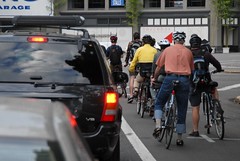“Retrofitting the cityscape for bicycles as a primary mode of transportation needs to be a priority.”
— Gill Kelley, outgoing director of the Planning Bureau
Whether you follow city politics or not, you’ve got to recognize that Portland is at an exciting point in its history.
Yes, we face major challenges, but we’ve got a fresh jolt of energy in City Hall, a new Mayor who will (hopefully) not shy away from big challenges, and we’re knee-deep into the Portland Plan; which, when complete, will “guide the physical, economic, social, cultural and environmental development of Portland over the next 30 years.”

Mayor Sam Adams recently merged the Planning Bureau with the Office of Sustainable Devlopment (creating the Bureau of Planning and Sustainability). In addition to that significant change (which the Oregonian likens to a “mad scientist experiment” in an editorial today), long-time Bureau of Planning Director Gill Kelley decided to step down.
Kelley was a respected city employee and will be remembered for playing a key role in transforming the Pearl District and with the creation of the South Waterfront district. On Saturday, he penned a parting shot about Portland’s future in The Oregonian.
In, Pair of initiatives offer paths for charting city’s future, Kelley stressed the importance of this moment for Portlanders:
Some cities, at critical times in their history, make extraordinary plans for their future: plans that vault them forward toward an enhanced identity — a place in the network of global cities and an increased sense of their own individuality. These might be called “intentional cities.”
In addition to his ideas on topics like nature in the city and building a healthy economy, Kelley includes a paragraph titled, The bicycle city and a new energy paradigm. In it, he writes:
The need to improve air quality drove much of our urban development and transit agenda in the 1970s and ’80s. Today’s imperative is to reduce greenhouse gases and increase energy self-reliance. Retrofitting the cityscape for bicycles as a primary mode of transportation needs to be a priority. By employing simpler, more decentralized and neighborhood-scale energy systems we improve our self-reliance and economic capacity.
When Mayor Adams released his ambitious 100 Days Plan, his staffers emphasized that he, “can’t make it happen by himself.”
We all know that a future where bikes are prioritized in planning is a sure path to a more sustainable, fun and healthy city; but we can’t sit back and hope that it will just happen on its own. Gill Kelley clearly understands the importance of bicycling, let’s do our part to make sure the City continues to get that message, and more importantly, act on it.
— Stay tuned to BikePortland.org for more coverage of this and other important planning initiatives. Learn more about The Portland Plan online.






the city is already ‘retrofitted’ for bicycles, the problem is all the motorists for whom the message hasn’t sunk in yet that roads are for cyclists too.
I think the city should spend a whole lot less time ‘retrofitting’ roads and a whole lot more time reeducating motorists.
wow this is fantastic!
we are making great strides here in nyc, though at times things seem to move slowly. it doesn’t help that our borough president is against a new bike lane path in Brooklyn http://brooklynbybike.wordpress.com/2009/01/08/a-bike-lane-fight-grows-in-brooklyn/
but it is great to see mayors make such an important investment in the city. go Portland!
Word!
What does Sam want me to do to help?
Retrofitting the cityscape for bicycles as a primary mode of transportation needs to be a priority.
This is a great thing to hear from the former planning director. It would be even greater to hear this from the current/future planning director–or Bureau of Planning & Sustainability director. It has been hard to keep up with all of the changes lately. Who is the new person in charge of this area?
“What does Sam want me to do to help?”
you’re getting ahead of me velocipede. I was planning to ask Sam’s staff that same question and do a story about it.
stay tuned.
BURR,
I have to agree. In these economic times, it would seem prudent to prioritize the “reeducation” of drivers over other means of increasing ridership. Maybe it would be less expensive.
Certainly the system of endless car subsidies needs to go away.
No more mega highways to far flung suburbs,
Eliminate on-street parking on bus routes.
Only alternate side parking.
Gas tax increases.
Insurance by the mile.
Usage (bridge) taxes, etc, etc.
No more free lunch for the car people. If you must have one, then you must pay.
The car subsidy is so extensive and comprehensive, it’s impossible to quantify, or even identify.
It’s called disincentive.
Car owners are the ultimate “special rights” group.
What several of you (starting with Burr) have suggested is something I’ve started thinking as well… that is, the mantra of “Policy, not just projects”.
I think Adams should consider a task force or subcommittee that examines how new policies could help achieve a more balanced transportation system.
Most policies can be done for little or no investment (besides staff time to come up with and implement them).
One of the big ones (for me) that has a major impact on bikeways is many areas that have on-street motor vehicle parking that crimps the bikeway. The movement of people in vehicles is much more important, in my opinion, than a space (especially when it’s free!) to park a private vehicle.
I also think a committee should look at places where roadway space and lanes could be re-configured to give more room to non-motorized vehicles (like the City did on the Hawthorne Bridge approach on SE Madison when they added a double-wide bikeway). A natural location would be the MLK/Grand couplet. On those streets, we give motor vehicles 6 lanes! (4 for driving on and 2 for parking on!). Those could become key bikeways if we re-allocated some of that space to bicycles.
Right on with the MLK/Grand couplet. After recently relocating near N. Williams St, I’m really surprised that there isn’t a great bike route heading into SE Portland without heading due east first. These areas would be great for a separated bike lane, which is what it would take for me to feel truly comfortable on these super=busy speedways.
I do not live in Portland, but as one interested in transportational cycling, I keep an eye on Portland affairs.
It is with some concern that I have read in some parts of the press and the blogosphere that Portland drivers tend to be very aggressive against cyclists, and that the Portland police are lax in enforcement of cyclists’ rights; indeed, that there have been several cycling deaths where the motorist has been clearly at fault but the local prosecutor has refused to act.
It is impossible to build a system of separate, interconnected, bicycle paths that would take cyclists everywhere they need to go with minimum need to share roadspace with cars; even if the money were available (a pretty big IF), there is simply no room. Ditto with separate bike lanes on streets (although there is a vocal faction that holds that such are actually MORE dangerous than streets without demarcated lanes, particularly at intersections). Hence, of the LAB’s Five E’s, the second two–Education and Enforcement–should be given priority.
License our bicycles and use the fees for public awareness and to encourage cycling and other sustainable initiatives.
Isn’t the streetcar coming to MLK/Grand, with construction starting as early as this summer? What does that mean for bikes there?
Couple comments:
1) The City is NOT “already retrofitted” for bikes. There are large portions of Portland that still have seen no or almost no investment in bike infrastructure. As with many of Portland’s liveability initiatives, the well-heeled, close-in neighborhoods are the only ones who have participated so far.
2) BAW is exactly right that a major issue is that there is little or no enforcement of the rules of the road as they pertain to biker safety. A few stiff fines would go a long way toward educating motorists, if only the PPB would try it sometime.
-John
I have to interject that the PPB has come a long way this past year.
They are working closely with the BTA and with bike and traffic safety staff at the City.
Also, the Bike Master Plan will have an entire chapter on enforcement.
Of course enforcement can always get better, but there is progress being made.
I didn’t see anyone answer Scott’s question, so…
The director of tne new Bureau of Planning and Sustainability is Susan Anderson – formerly director of the Office of Sustainable Development.
Her bio:
http://www.portlandonline.com/osd/index.cfm?c=42756&
Agree with BAW (@10) and Mulvey (@13) about BAW’s second point regarding increasing enforcement and education of drivers about existing law! Saving bicycling citizens’ lives and increasing safety by applying Skilcraft to a few books of tickets should be worth a few dedicated PPB officers’ time.
Disagree with BAW about there being no room! Saying there is no room to add cyclist infrastructure is a statement that likely proceeds from the long ingrained American car-centric thinking which we as a culture have been raised in. As much as I am loathe to bow to foreign nations, I gotta point to the Netherlands, again. Their cities existed when Elly’s current image of DC was swampland, and their streets and avenues remain typically as narrow as was the norm for the age. Yet, they managed to install cycle tracks along with their accommodation of automobiles as well as develop a civilized attitude about sharing the road. They are neither superwomen and supermen nor a primitive society starting from scratch. If they can fit bikes into their mix and generate a healthy economy and transport grid, then the richest nation in history is just not trying hard enough …yet.
car culture just re-acts, we need to invest it smart methods of transport!
I get this feeling people really are attached to a them.. sooo glad i broke free again, bikes are clean energry!!
people just drive toooo damn much!
Whatever we do, we’ve got to find a way to hit people at the DMV testing level. IMO, it is essential for there to be some kind of extra, bicycle-traffic material for drivers in Multnomah, Washington, Clackamas, Lane, and Benton Counties at the very least.
It certainly won’t solve every problem we have with motorists, but I think it’s an excellent place to start.
“well heeled” inner city neighborhoods, whatever. Thats such a misrepresentation of Portland its not even funny! This city is cheap and bohemian by almost any standard. Lake Oswego would barely even qualify as compared to places in California or the East Coast.
Even the Pearl District, in assuming you were referring to this particular neighborhood, is sorely lacking bike-specific infrastructure. I think it has 2 streets w/bike lanes? Naito and 14th?
I swear we need full-lane cycle tracks running the entire lengths of Division, Hawthorne, 39th, and Burnside. And stat!
“We need full-lane cycle tracks running the entire lengths of Division, Hawthorne, 39th, and Burnside.”
Yes yes, y’all~!!!
“Retrofitting the cityscape for bicycles as a primary mode of transportation needs to be a priority..” is not at all the same as the headline’s “should be “primary mode of transportation”.” One letter makes a lot of difference.
I agree those that can should emphasize bicycle use. For those that can’t or don’t want to, pub transport should be emphasized.
Part of elevating bicycles to a main mode of transportation in PDX should be a massive education program for drivers AND riders.
I live and ride in the Gorge, but, due to distance, I drive to PDX by car. I often drive after dark, and am surprised how many riders still don’t use any lighting whatsoever, and how many more still don’t wear helmets.
This has got to change for the partnership and attitude between drivers and riders to improve (along with more courteous, less aggressive, driving, of course), and for bicyclists as a group to gain status as respectable traffic participants.
It’s only a minority who doesn’t light up, but I remember the beginning days of snowboarding: a few idiots delayed equality of boarders with skiers
by a decade!
Agree with juniormarbles. I ride from NoPo to PSU daily, and actually have very few dangerous encounters with drivers. On the other hand, I do see many bikers out there doing stupid stuff. Re-education is a two-way street.
“We need full-lane cycle tracks running the entire lengths of Division, Hawthorne, 39th, and Burnside.”
Agreed. It has always been my dream that these narrow 4-laned thoroughfares could be turned into 2 lane roads with a middle turning lane and bicycle lanes. There’s plenty of room for all that, even with on-street parking to boot (Hawthorne comes to mind here).
We need to register the cycles and create some revenue to pay for all these additions. Require all cycles to be licensed.
oh this when down hill! ahhhhh!
Yikes, why license bicycles? They’re meant to be an inexpensive mode of transportation, and they do far, far less harm than cars! There is less damage to roads, no pollution after the production of the bike, etc, etc.
There needs to be education on both sides – certainly many people driving cars need more education about cyclists on roads, but cyclists also need to be made aware of the rights and wrongs, the do’s and do-nots.
And, city planners need to think a little more before putting in tons of Max tracks in downtown Portland! As a PSU student who commutes to school by bike, it has become increasingly hard to get to and from school due to the new Max tracks – making a right turn from 6th onto Madison poses a great hazard, as do the turtles in the painted white lines that separate the car lane from the Max lane. The concrete itself is slippery on wet days, and as an experienced cyclist, I have nearly gone down twice. I sure hope the Max gains ridership, or those tracks will be a waste, in my opinion.